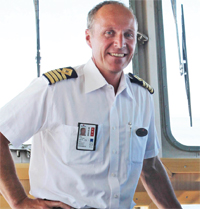Captain Bengt Viknander, from Sweden, has been captain on Stena Danica for the past two years. The ship, however, has been on the Frederikshavn-Gothenburg route for much longer. Built in 1983, Stena Danica has been working on the same route for 30 years, an event celebrated in March 2013, when all passengers were given some cake.
When did you start at sea?I started in 1983 on a fishing boat, trawling for herring in the waters between Sweden and Denmark, and then worked in the North Sea for a year. I went to college to study seamanship after that, and in 1986 went to sea as an AB on board a Swedish Maritime Administration ship, the 50m by 12m Scandica, working on the maintenance of lighthouses and buoys; she had a large crane to lift the buoys. I worked on her for 18 months.
What other ships have you worked on?I worked for Vingatank on tankers from 1988 until 1991 and then I worked for a year and a half ashore at Gothenburg VTS. In 1993 I went on Gorthon Lines’ dry cargo vessel Stig Gorthon, and our main cargo was paper. We usually operated on a route from Finland to Antwerp and Bilbao. In 1994 I started training to be a master mariner and went to sea during that time as part of the training. Igraduated in December 1997 and had my first job as second officer on another Gorthon dry cargo vessel, Alida Gorthon.
When did you start working on ferries?I started working for Stena in 2003 on one of the ro-ro vessels, Stena Freighter, running between Gothenburg and Travemünde. The first Stena Freighter was an old ship, and she was replaced in 2004 by a new Stena Freighter, but the route closed in 2010. I was Chief Officer and then, for the last year, was Captain. After that I moved to Stena Nautica, running between Denmark and Sweden, and started on Stena Danica in May 2012.

What are the crewing arrangements? Where are the crew from?We have a flexible manning system, with more crew when there are the most passengers being carried. We have between 85 and 100 crew depending on the number passengers. Sometimes in winter we have fewer crew if we are mainly carrying freight. There are 30 crew, including apprentices, that operate the ship, from captain and officers to engineers and motormen. The officers work one week on, two weeks off, and the ratings one week on and one week off.
Can you describe the route operated by Stena Danica? Normally we complete two return crossings a day, with a different timetable for the summer. The ship leaves Gothenburg at 0815, arrives at Frederikshavn at 1230, departs at 1410, and reaches Gothenburg again at about 1725. We depart at 1845 and return to Gothenburg at 0240 the next day. We do have cabins which are for lorry drivers who can rest, shower and relax between their journeys. This is the busiest route between Denmark and Sweden, and Danica shares it with Stena Jutlandica. There is also Stena Scanrail, which is mainly a freight ship, as well as Stena Carisma, but she will be laid up for the winter. We have four masters on the route, including senior master. On a summer day in the holidays we carry over 1,000 passengers, and have a maximum capacity of over 2,000, most of whom bring their cars. During the winter we carry more lorries; this ship is a ro-pax, as is Jutlandica, which has a smaller passenger capacity and was built in 1996 to replace the previous Jutlandica.
How have ships changed in your time on board?The changes have come mainly with bridge design: modern ships have bigger windows, while the main features on the bridge are more accessible. And electronic charts mean we have up-to-date charts every week. This ship has been on the route for 30 years and so she has a mixture of old and new equipment on the bridge; she was a very modern and well-equipped ship when completed in 1983

Read A View From The Bridge every month in Ships Monthly – subscribe here


